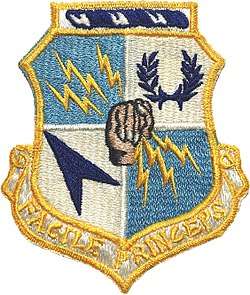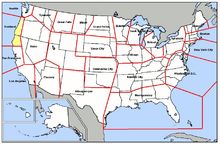Portland Air Defense Sector
The Portland Air Defense Sector (PADS) is an inactive United States Air Force organization. Its last assignment was with the 25th Air Division, being stationed at Adair Air Force Station, Oregon. It was inactivated on 1 April 1966.
Portland Air Defense Sector
 | |
|---|---|
 Emblem of the Portland Air Defense Sector | |
| Active | 1948-1966 |
| Country | United States |
| Branch | United States Air Force |
| Role | Air Defense |
| Part of | Air Defense Command |
| Commanders | |
| Notable commanders | Carroll W. McColpin |

History
PADS was established in June 1958 assuming control of former ADC Western Air Defense Force units in eastern Oregon and northwest California. The organization provided command and control over several aircraft and radar squadrons.
On 1 June 1960 the new Semi Automatic Ground Environment (SAGE) Direction Center (DC-13) became operational. 44°40′15″N 123°12′58″W DC-13 was equipped with dual AN/FSQ-7 Computers. The day-to-day operations of the command was to train and maintain tactical flying units flying jet interceptor aircraft (F-94 Starfire; F-102 Delta Dagger; F-106 Delta Dart) in a state of readiness with training missions and series of exercises with SAC and other units simulating interceptions of incoming enemy aircraft.
The Sector was inactivated on 1 April 1966 as part of an ADC consolidation and reorganization; and its units were reassigned to 28th Air Division. The 689th Radar Squadron (SAGE) was rehomed to DC-12, 25th Air Division, McChord AFB, WA on 1 April 1966.
Lineage
- Established as Portland Air Defense Sector on 8 June 1958
- Inactivated on 1 April 1966
Assignments
- 25th Air Division, 8 June 1958 – 1 April 1966
Stations
- Adair Air Force Station, Oregon, 8 June 1958 – 1 April 1966
Components
Groups
- 337th Fighter Group (Air Defense)
- Portland IAP, Oregon, 15 April 1960-25 March 1966
- 408th Fighter Group (Air Defense)
- Kingsley Field, Oregon, 15 April 1960-1 April 1966
Interceptor squadron
- 82d Fighter-Interceptor Squadron
- Travis AFB, California, 1 August 1963-1 April 1966
Radar squadrons
|
|
See also
- List of USAF Aerospace Defense Command General Surveillance Radar Stations
- Aerospace Defense Command Fighter Squadrons
References
![]()
- A Handbook of Aerospace Defense Organization 1946 - 1980, by Lloyd H. Cornett and Mildred W. Johnson, Office of History, Aerospace Defense Center, Peterson Air Force Base, Colorado
- Winkler, David F. (1997), Searching the skies: the legacy of the United States Cold War defense radar program. Prepared for United States Air Force Headquarters Air Combat Command.
- Maurer, Maurer (1983). Air Force Combat Units Of World War II. Maxwell AFB, Alabama: Office of Air Force History. ISBN 0-89201-092-4.
- Ravenstein, Charles A. (1984). Air Force Combat Wings Lineage and Honors Histories 1947-1977. Maxwell AFB, Alabama: Office of Air Force History. ISBN 0-912799-12-9.
- Radomes.org Air Defense Radar Stations
| External image | |
|---|---|
